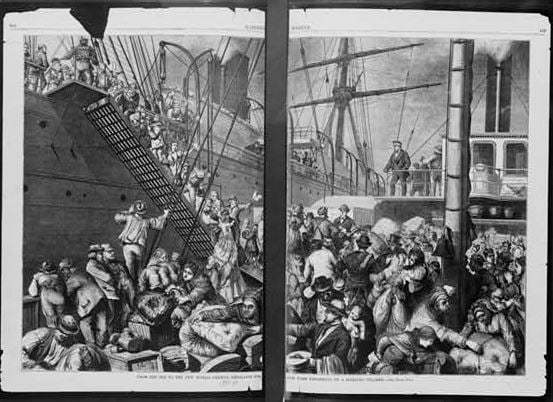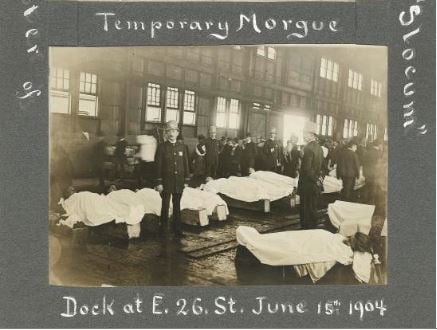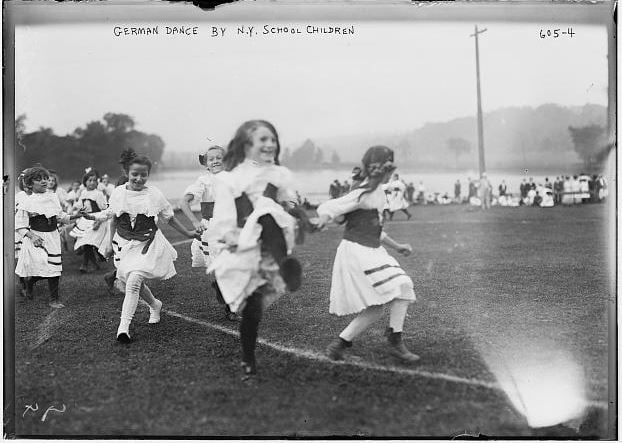Blog Archive
The Decline and Fall of Kleindeutschland
You have to be pretty diligent to see the remains of Kleindeutschland in the Lower East Side today. Kleindeutschland was once a thriving community, and while most discussions of Manhattan real-estate don’t mention it, the General Slocum Disaster made as dramatic an impact on the Lower East Side as, for instance, the High Line is making to the Meatpacking district.

The early waves of German immigrants were for the most part welcomed to the Lower East Side as they were seen as a 'clean teutonic' people. This woodcut from a 1874 issue of Harper's shows a boat departing Hamburg for New York. Photo courtesy of The Library of Congress.
The General Slocum disaster was the single deadliest in New York prior to the 9/11 attacks. The event is named after the steamboat S.S. General Slocum which launched on June 15, 1904 carrying mostly women and children from St. Mark’s Evangelical Lutheran Church on 6th street to the North Shore of Long Island for a summer outing.
Records suggest that about 1,350 people would have been on the Slocum, including crew. The boat was steaming up the East River towards Long Island when it caught fire. It had gone only about as far as 97th Street. The boat was made mostly of wood: white oak, locust and yellow pine. More than a thousand people died as the ship burned from the deck down to the water line in less than 15 minutes.
Though a fire inspector had recently deemed the vessel safe, the hoses on board were rotten and burst when the crew attempted to use them. What life preservers were onboard also turned out to be rotten and utterly useless. Few of the passengers knew how to swim and most likely the fashions of the time did little to aid their efforts.

The fire is thought to have been started accidentally but controversy persists as to whether the Captain could have brought the ship to shore sooner, thereby saving more passengers. Photo courtesy of the Library of Congress.
The outing had been chartered by the St. Mark’s church for $350, which today would be close to $9,000. This number means nothing in the face of the lives which were lost, but this can help us understand how economically stable and unified the community once was. Kleindeutschland, home to 150,000 people of German descent, was at one time the third largest “German city” in the world after Berlin and Vienna. With a thousand people lost, few families in this close community escaped the tragedy. Funerals went on for several weeks after the tragedy, so many funerals occurred that for a time, there was said to be a funeral every four minutes.

The dock at E. 26th Street was made into a temporary morgue to accommodate the 1000 casualties, some of whom were never identified. Photo courtesy of the Library of Congress.
The community was so unilaterally affected that depression became endemic in the survivors, mostly men, fathers, brothers, and uncles who had been at working at the time of the excursion. In the wake of the disaster, there were several suicides and many residents moved away from the Lower East Side to distance themselves from a neighborhood which was so infected by grief. The disaster became a very emotional push factor for what at first seemed a thriving community. In reality there were a few other contributing factors to the dissolution of Kleindeutschland. By the late 1880s some of the second generation of German immigrants, with their greater command of English, were beginning to settle in other neighborhoods and cities. This period also saw the beginning of a marked increase in Jewish and Italians immigrants, who actually began moving to this neighborhood shortly before the Slocum disaster.
As Immigrant communities often provide support and comfort for countrymen outside of their homeland, it is hard for us today to imagine a disaster disturbing enough to undermine the reassurances of shared language and custom. German speaking communities did gather again in other parts of the city, and of course in other states, but Kleindeutschland became a thing of the past.

It is interesting to consider how strong the German community might have remained in the Lower East Side had it not been for this disaster. Here children of German descent practice a German dance in a N.Y. public school. Photo courtesy of the Library of Congress.
– Julia Berick, Marketing and Communications Coordinator.